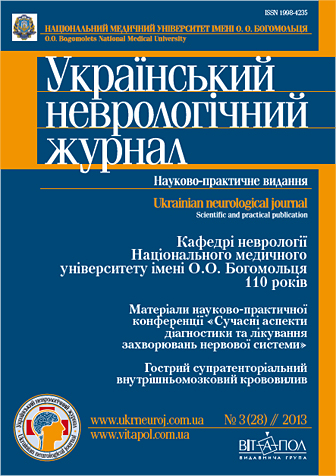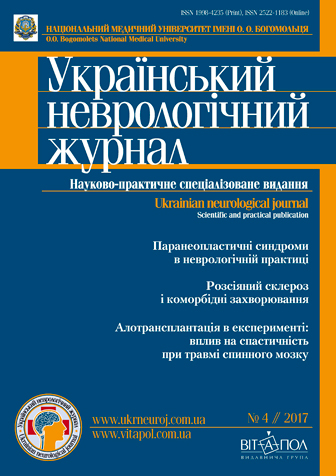- Issues
- About the Journal
- News
- Cooperation
- Contact Info
Issue. Articles
№3(28) // 2013

1.
|
Notice: Undefined index: picture in /home/vitapol/ukrneuroj.vitapol.com.ua/en/svizhij_nomer.php on line 74 Notice: Undefined index: pict in /home/vitapol/ukrneuroj.vitapol.com.ua/en/svizhij_nomer.php on line 75 Analysis of epidemiological rates of multiple sclerosis in Volyn regionN. V. Bobryk, O. D. Shulga, L. I. Sokolova |
|---|
Objective — to analyze epidemiological rates of MS in the Volyn region and to determine if risk of multiple sclerosis is associated with month of birth in patients of Volyn region.
Methods and subjects. Health records outpatients with multiple sclerosis who are observed in the center of demyelinating diseases of Volyn Regional Hospital and Medical Documentation of local district polyclinics and clinics of Lutsk were analyzed. 825 patients with MS, 542 of them — females, 283 — males were registered, mean age 46,4 ± 11,3 years, it was analyzed the following data: month and year of birth, age of first appearance of symptoms, date of diagnosis of multiple sclerosis.
Results. It was identified districts in the Volyn region with the highest and lowest prevalence of MS. The highest prevalence is in the age group 32—59 years. The average age of onset is 30.1 ± 9.2 years. The average time from onset of symptoms to establish definite MS is 5.9 ± 6.7 years, has inverse relationship with a year early disease. The proportion of patients with relapsing-remitting course in Volyn Region is 13.3 %, relapsing-progressive course — 56 %, secondary progressive — 13.5 % and primary progressive — 17.2 %. The risk of developing MS for births in February, April and August is more in 1.63; 1.66 and 1.57 times respectively compared with those who born in October and November.
Conclusions. The main bulk of cases of MS in Volyn region are subjects of working age. Prevalence rates of MS in different parts of Volyn region are heterogeneous. The time interval between the occurrence of symptoms and the establishment of definite MS was reduced significantly over the past decades. Risk of MS for born in April, February and August is significantly higher than for born in October or November.
Keywords: multiple sclerosis, epidemiology, prevalence, birth month.
Notice: Undefined variable: lang_long in /home/vitapol/ukrneuroj.vitapol.com.ua/en/svizhij_nomer.php on line 188
2.
|
Notice: Undefined index: picture in /home/vitapol/ukrneuroj.vitapol.com.ua/en/svizhij_nomer.php on line 74 Notice: Undefined index: pict in /home/vitapol/ukrneuroj.vitapol.com.ua/en/svizhij_nomer.php on line 75 Mechanisms of occurrence and treatment methods of fatigue syndrome in multiple sclerosisT. I. Nehrych, S. Y. Kyrylyuk |
|---|
Objective — to assess the efficacy of a combination product of folic acid and potassium iodide — Yodofol — in treatment of fatigue syndrome in patients with multiple sclerosis (MS).
Methods and subjects. We examined 20 MS patients with relapsing-remitting course in remission who complain of fatigue. Mean age was 35.4 ± 1.9 years. Patients received Yodofol one tablet a day for three months. All patients underwent a complete clinical and neurological examination and fatigue was assessed using the scale-questionnaires.
Results. Significant reduction of fatigue impact on patients’ life activity,their cognitive, psycho-sociological and physical state was evidenced after the treatment. It was observed in score on MFIS scale. According to the scale FDS, frequency and severity of fatigue syndrome and the number of patients with asthenia and with fatigue during normal physical activities were decreased.
Conclusions. During treatment of Yodofol significant reduction in the severity of fatigue syndrome in patients with multiple sclerosis was observed. It was confirmed by decrease in score of scales after three months of treatment.
Keywords: multiple sclerosis, fatigue syndrome, Yodofol.
Notice: Undefined variable: lang_long in /home/vitapol/ukrneuroj.vitapol.com.ua/en/svizhij_nomer.php on line 188
3.
|
Notice: Undefined index: picture in /home/vitapol/ukrneuroj.vitapol.com.ua/en/svizhij_nomer.php on line 74 Notice: Undefined index: pict in /home/vitapol/ukrneuroj.vitapol.com.ua/en/svizhij_nomer.php on line 75 Peculiarities of course and functional outcomes in patients with acute supratentorial intracerebral hemorrhage depending on the level of blood glucoseO. A. Myalovitska, S. V. Rogoza |
|---|
Оbjective — to study the influence of stress-induced hyperglycemia on the course and functional outcomes in patients with type 2 diabetes mellitus and in nondiabetic ones in acute period of spontaneous supratentorial hypertensive intracerebral haemorrhage.
Methods and subjects. We have studied 75 patients in acute period of supratentorial hypertensive intracerebral hemorrhage. Patients were divided into three groups depending on the presence of diabetes mellitus and blood glucose level: 1st group included 44 nondiabetic patient with blood glucose level less than 7.0 mmol/l, 2nd group included 18 patient with stress-induced hyperglycemia over 7.0 mmol/l, and the 3rd group included 13 patients with type 2 diabetes mellitus. Efficacy of treatment was evaluated with the use of modern neurological scales such as NIHSS, modified Rankin scale, Barthel Index.
Results. Patients with type 2 diabetes mellitus and stress-induced hyperglycemia 10 mmol/l and over had greater severity of stroke assessed by the NIHSS scale and worse radiographic characteristics of intracerebral hemorrhage. No significant differences in functional outcomes on 21st day of treatment between groups were revealed. Fatal outcomes were observed more frequently among patients with stress-induced hyperglycemia and type 2 diabetes mellitus.
Conclusions. Type 2 diabetes mellitus and stress-induced hyperglycemia are associated with greater severity of intracerebral hemorrhage and death in acute period of spontaneous supratentorial hypertensive intracerebral haemorrhage.
Keywords: intracerebral hemorrhage, stress-induced hyperglycemia, diabetes mellitus, functional outcomes.
Notice: Undefined variable: lang_long in /home/vitapol/ukrneuroj.vitapol.com.ua/en/svizhij_nomer.php on line 188
4.
|
Notice: Undefined index: picture in /home/vitapol/ukrneuroj.vitapol.com.ua/en/svizhij_nomer.php on line 74 Notice: Undefined index: pict in /home/vitapol/ukrneuroj.vitapol.com.ua/en/svizhij_nomer.php on line 75 The role of neuroprotective therapy for neurological functions recovery in patients with acute ischemic strokeM. M. Prokopiv |
|---|
Objective — to compare clinical efficacy of various neuroprotectors for patients with acute ischemic stroke.
Methods and subjects. 178 patients aged 40 — 79 years (mean age 60.5 ± 10.4) with acute ischemic stroke were under the clinical and neurological examination. They were arranged in 5 experimental groups and one control group. The following information was analyzed: dynamic of patients subjective data and their neurological state description by means of NIHSS scale, modified Rankin scale, Barthel Index and Global test during 90 days of disease.
Results. Neurological state dynamic, disability level and functional sufficiency evidenced the neuroprotective therapy efficacy for patients with acute ischemic stroke. The application of Corvitin and Ceraxon combination was the most effective: high efficacy was recorded in 82.9 % patients on 21st day, in 87.1 % patients on 90-th day, in the group of standard therapy the same results were in 35.5 and 48.4 % respectively. In 3 months complete recovery was recorded in 37.1 % patient who were treated with Corvitin and Ceraxon combination, in 29.0 % patients treated separately with Corvitin or Ceraxon, and in 22.6 % patients treated with standard therapy.
Conclusions. The application of Corvitin, Ceraxon, Cere-brolisyn, Actovegyn facilitates the ischemic stroke treatment efficacy in comparison with standard therapy which does not include neuroprotectors application. Combined neuroprotection with Corvitin, and Ceraxon evidenced significant improvement of ischemic stroke treatment in comparison with mono- neuroprotective treatment and also it increased the efficacy of Actovegyn or Cere-brolisyn application.
Keywords: acute ischemic stroke, pathophysiology of ischemic penumbra, neuroprotection.
Notice: Undefined variable: lang_long in /home/vitapol/ukrneuroj.vitapol.com.ua/en/svizhij_nomer.php on line 188
5.
|
Notice: Undefined index: picture in /home/vitapol/ukrneuroj.vitapol.com.ua/en/svizhij_nomer.php on line 74 Notice: Undefined index: pict in /home/vitapol/ukrneuroj.vitapol.com.ua/en/svizhij_nomer.php on line 75 Gliatilin impact on the functional state of the brain in elderly patients with ischemic strokeS. M. Kuznetsova, T. Yu. Romanuk |
|---|
Objective – to analyze the impact of protracted treatment with Gliatilin on the functional state of the brain in elderly patients with ischemic stroke (recovery period.
Methods and subjects. 29 elderly patients with ischemic stroke (early recovery period) were examined. Mean age was 63.6 ± 3.2 years. Protracted treatment with Gliatilin included 10 intravenous injections of 1000 mg per day, then 1 capsule (400 mg) 2 times per day for 20 days.
Results. It was established that in patients with ischemic stroke, Gliatilin increases daily life activity on Rankin scale (from 2.79 ± 0.13 points to 1.87 ± 0.12, p < 0.05), improves cognitive function (on MMSE scale). In patients with stroke, Gliatilin has vasoactive and metabolic effects: improves cerebral hemodynamic, increases cerebral blood flow velocity and decreases peripheral resistancem, indices in separate vessels in the anterior and posterior cerebral circulation, the reorganization of brain bioelectric activity was observed, characterized by a decline in the overall structure of the EEG intensity in the range slow rhythms simultaneously with increases intensity in the range of the α-rhythm.
Conclusions. Based on the results of a comprehensive analysis of the Gliatilin impact on the functional state of the brain in patients with ischemic stroke, it is possible to recommend the inclusion of this drug in rehabilitation of these patients.
Keywords: ischemic stroke, cerebral hemodynamic, electrical activity of the brain, Gliatilin.
Notice: Undefined variable: lang_long in /home/vitapol/ukrneuroj.vitapol.com.ua/en/svizhij_nomer.php on line 188
6.
|
Notice: Undefined index: picture in /home/vitapol/ukrneuroj.vitapol.com.ua/en/svizhij_nomer.php on line 74 Notice: Undefined index: pict in /home/vitapol/ukrneuroj.vitapol.com.ua/en/svizhij_nomer.php on line 75 Clinical, neuropsychological and neurophysiological effectiveness of donepezil hydrochloride treatment for elderly patients in the mild stage of Alzheimer and vascular dementia typesI. F. Rozeliuk |
|---|
Оbjectіve — to study the effectiveness of donepezil hydrochloride (Almer, Actavis) for elderly patients in the mild stage of Alzheimer and vascular dementia types.
Methods and subjects. The 3-month clinical study included 38 elderly patients (mean age — (71.03 ± 1.20) years) with dementia. All patients underwent clinical, neurological, laboratory, instrumental (electrocardiography, CT/MRI brain, qEEG) and neuropsychological examination.
Results. It was found that the treatment with Almer for elderly patients in the mild stages of dementia has a positive effect on their overall condition, the function of memory, language, praxis, and behavioral characteristics, improves patients' daily activities, is accompanied by a positive changes on the bioelectric activity of the brain.
Conclusions. The results indicate good effectiveness, tolerability and safety of donepezil hydrochloride in the treatment of elderly patients with dementia syndrome in the mild stages. Almer can be recommended as one of the drugs of choice treatment of cognitive impairment in the mild stages of Alzheimer and vascular dementia types.
Keywords: dementia, age, treatment, donepezil hydrochloride, Almer.
Notice: Undefined variable: lang_long in /home/vitapol/ukrneuroj.vitapol.com.ua/en/svizhij_nomer.php on line 188
7.
|
Notice: Undefined index: picture in /home/vitapol/ukrneuroj.vitapol.com.ua/en/svizhij_nomer.php on line 74 Notice: Undefined index: pict in /home/vitapol/ukrneuroj.vitapol.com.ua/en/svizhij_nomer.php on line 75 Quality of life and pharmacological aspects of treatment of patients with lumbosacral radiculopathyH.V. Grytsay, M.S. Manuylov |
|---|
Objective — to study the effectiveness of Xefocam and Neurobion combination, in the treatment of vertebral radiculopathy from the point of life quality.
Methods and subjects. 31 patients with lumbosacral radiculopathy (12 women, 19 men), aged 26 to 65 years old, were examined. The general clinical and biochemical blood count, neurological examination were conducted; VAS, the Short Form-36, McGill Pain Questionnaire were filled before and after 10 days of hospitalization.
Results. The improvement of patients state was observed after the treatment (significant elevation of pain syndrome, regress of muscle tonic symptom, sensitivity dysfunction decreasing, increasing of SF-36 indexes according to scales of physical health component and role functioning) due to Xefocam and Neurobion combination application.
Conclusions. The importance of quality of life assessment among these patients was proved. The positive change of quality of life parameters was positive dynamic of life quality as a result of Xefocam and Neurobion combination application.
Keywords: lumbosacral radiculopathy, quality of life, pain, functional capacity, neurotropic vitamin.
Notice: Undefined variable: lang_long in /home/vitapol/ukrneuroj.vitapol.com.ua/en/svizhij_nomer.php on line 188
8.
|
Notice: Undefined index: picture in /home/vitapol/ukrneuroj.vitapol.com.ua/en/svizhij_nomer.php on line 74 Notice: Undefined index: pict in /home/vitapol/ukrneuroj.vitapol.com.ua/en/svizhij_nomer.php on line 75 Cholinergic pharmacotherapy of dementia: possibilities and criteria of drug choiceS.G. Burchinsky |
|---|
In the present paper the modern problems of pharmacotherapy of different forms of dementia have been reviewed. A concept of cholinergic pharmacotherapy as an effective way of influence on cognitive decline has been grounded. Presented drugs of this group, peculiarities of their action mechanism, clinical effects and disadvantages have been analyzed. The main attention is paid to selective acetylcholinesterase inhibitor rivastigmin as an instrument of treatment strategy of neurodegenerative and vascular forms of dementia. Analysis of its advantages comparing with other drugs of this group, and grounding of expediency of its use in different forms of cognitive, behavior, and psychic impairments in dementia are presented.
Keywords: dementia, cholinergic pharmacotherapy, rivastigmin.
Notice: Undefined variable: lang_long in /home/vitapol/ukrneuroj.vitapol.com.ua/en/svizhij_nomer.php on line 188
9.
|
Notice: Undefined index: picture in /home/vitapol/ukrneuroj.vitapol.com.ua/en/svizhij_nomer.php on line 74 Notice: Undefined index: pict in /home/vitapol/ukrneuroj.vitapol.com.ua/en/svizhij_nomer.php on line 75 Особенности течения и функциональных исходов у больных с острым супратенториальным внутримозговым кровоизлиянием в зависимости от уровня глюкозы в кровиЕ. А. Мяловицкая, С. В. Рогоза |
|---|
Цель — изучить влияние стрессовой гипергликемии на течение и функциональные исходы у пациентов с сахарным диабетом и без него в острый период спонтанного супратенториального внутримозгового кровоизлияния на фоне артериальной гипертензии.
Материалы и методы. Обследованы 75 пациентов с супратенториальным внутримозговым кровоизлиянием на фоне артериальной гипертензии. В зависимости от наличия сахарного диабета и показателей глюкозы крови пациентов распределили на три группы. В первую группу вошли 44 пациента без сахарного диабета с уровнем глюкозы в крови при госпитализации менее 7,0 ммоль/л, во вторую — 18 больных со стрессовой гипергликемией выше 7,0 ммоль/л, в третью — 13 пациентов с сахарным диабетом 2 типа. Эффективность лечения оценивали с использованием шкалы NIHSS, модифицированной шкалы Рэнкина, индекса Бартел.
Результаты. Пациенты с сахарным диабетом 2 типа и стрессовой гипергликемией 10 ммоль/л и выше имели более выраженный неврологический дефицит по шкале NIHSS и худшие томографические характеристики внутримозгового кровоизлияния. На 21-е сутки лечения не выявлено достоверных различий в функциональных исходах между группами, однако среди пациентов со стрессовой гипергликемией и сахарным диабетом 2 типа чаще имел место летальный исход.
Выводы. Сахарный диабет 2 типа и стрессовая гипергликемия ассоциируются с более тяжелым течением внутримозгового кровоизлияния и смертью в острый период спонтанного супратенториального внутримозгового кровоизлияния у пациентов с артериальной гипертензией.
Keywords: внутримозговое кровоизлияние, стрессовая гипергликемия, сахарный диабет, функциональные исходы.
Notice: Undefined variable: lang_long in /home/vitapol/ukrneuroj.vitapol.com.ua/en/svizhij_nomer.php on line 188
10.
|
Notice: Undefined index: picture in /home/vitapol/ukrneuroj.vitapol.com.ua/en/svizhij_nomer.php on line 74 Notice: Undefined index: pict in /home/vitapol/ukrneuroj.vitapol.com.ua/en/svizhij_nomer.php on line 75 Анализ эпидемиологических показателей рассеянного склероза в Волынской областиН. В. Бобрик, О. Д. Шульга, Л. И. Соколова |
|---|
Цель — провести анализ эпидемиологических показателей рассеянного склероза (РС) в Волынской области и определить зависимость возникновения РС от месяца рождения в волынской когорте больных.
Материалы и методы. Проанализированы медицинские карты амбулаторных больных с РС, находящихся на диспансерном учете в центре демиелинизирующих заболеваний Волынской областной клинической больницы, и медицинская документация участковых районных поликлиник и поликлиник г. Луцка. Зарегистрированы 825 больных, среди них было 542 женщины, 283 мужчины. Средний возраст — (46,4 ± 11,3) года. Проведен анализ следующих данных: месяц, год рождения, возраст возникновения первых симптомов болезни, дата установления диагноза РС.
Результаты. Определены районы в Волынской области с наибольшей и наименьшей распространенностью РС. Наибольшая распространенность — в возрастной группе 32—59 лет. Средний возраст начала заболевания — (30,1 ± 9,2) года. Средняя длительность периода от появления первых симптомов до установления диагноза достоверного РС — (5,9 ± 6,7) года. Этот показатель имеет обратную связь с годом начала болезни. Доля пациентов с ремиттирующим течением в Волынской области составляет 13,3 %, с ремиттирующе-прогресси‑ующим — 56 %, с вторично-прогрессирующим — 13,5 %, с первично-прогредиентным — 17,2 %. Риск развития РС для рожденных в феврале, апреле и августе больше в 1,63; 1,66 и 1,57 раза соответственно по сравнению с рожденными в октябре и ноябре.
Выводы. Основная доля случаев РС на Волыни приходится на лиц трудоспособного возраста. Показатели распространенности РС в разных районах Волынской области являются гетерогенными. Период между возникновением первых симптомов и установлением диагноза достоверного РС значительно сократился в последние десятилетия. Риск развития РС для рожденных в апреле, феврале и августе значительно выше, чем для родившихся в октябре или ноябре.
Keywords: рассеянный склероз, эпидемиология, распространенность, месяц рождения.
Notice: Undefined variable: lang_long in /home/vitapol/ukrneuroj.vitapol.com.ua/en/svizhij_nomer.php on line 188
11.
|
Notice: Undefined index: picture in /home/vitapol/ukrneuroj.vitapol.com.ua/en/svizhij_nomer.php on line 74 Notice: Undefined index: pict in /home/vitapol/ukrneuroj.vitapol.com.ua/en/svizhij_nomer.php on line 75 Роль нейропротекторной терапии в восстановлении неврологических функций у больных с острым ишемическим инсультомМ. М. Прокопив |
|---|
Цель — сравнить клиническую эффективность разных нейропротекторных препаратов у больных с острым ишемическим инсультом.
Материалы и методы. Проведено клинико-неврологическое обследование 178 больных с острым ишемическим инсультом в возрасте от 40 до 79 лет (средний возраст — (60,5 ± 10,4) года), которых в зависимости от примененной терапии распределили на 5 опытных групп и контрольную группу. Оценивали динамику субъективных данных больных и неврологического статуса с использованием шкал NIHSS, модифицированной шкалы Рэнкина, индекса Бартел и Глобального теста на протяжении 90 дней заболевания.
Результаты. Динамика неврологического статуса, степени инвалидизации и функциональной независимости пациентов свидетельствовала об эффективности нейропротекторной терапии в лечении больных с ишемическим инсультом. Наиболее эффективным было применение комбинации Корвитина и Цераксона: высокую эффективность на 21-е сутки зафиксировали у 82,9 % больных, на 90-е сутки — у 87,1 %, в группе стандартной терапии — соответственно у 35,5 и 48,4 % пациентов. Через 3 мес наблюдения полное выздоровление отметили у 37,1 % пациентов, которые получали лечение Корвитином в сочетании с Цераксоном, у 29,0 %, которые получали лечение Корвитином, у 29,0 %, которые получали лечение Цераксоном, и у 22,6 %, которые получали стандартную терапию.
Выводы. Применение у больных с острым ишемическим инсультом препаратов Цераксон, Корвитин, Церебролизин, Актовегин способствует повышению эффективности лечения по сравнению со стандартной терапией, которая не предусматривает назначения нейропротекторного препарата. Комбинированная нейропротекция с использованием Корвитина (кверцетина) и Цераксона (цитиколина) существенно повышала эффективность лечения острого ишемического инсульта по сравнению с монотерапией этими препаратами, а также превышала эффективность применения Церебролизина или Актовегина.
Keywords: острый ишемический инсульт, патофизиология ишемической полутени, нейропротекция.
Notice: Undefined variable: lang_long in /home/vitapol/ukrneuroj.vitapol.com.ua/en/svizhij_nomer.php on line 188
Current Issue Highlights
№4(45) // 2017

Paraneoplastic syndromes in neurological practice
E. G. Dubenko, L. I. Kovalenko
Analysis of comorbid diseases in patients with multiple sclerosis
Т. І. Nehrych, К. М. Hychka
Comparative analysis of the rat’s paretic limb spasticity against the background of spinal cord injury, adult olfactory bulb and fetal cerebellum tissue allotransplantation
V. I. Tsymbaliuk 1, 2, V. V. Medvediev 2, Yu. Yu. Senchyk 3, N. G. Draguntsova 1
Log In
Notice: Undefined variable: err in /home/vitapol/ukrneuroj.vitapol.com.ua/blocks/news.php on line 50

